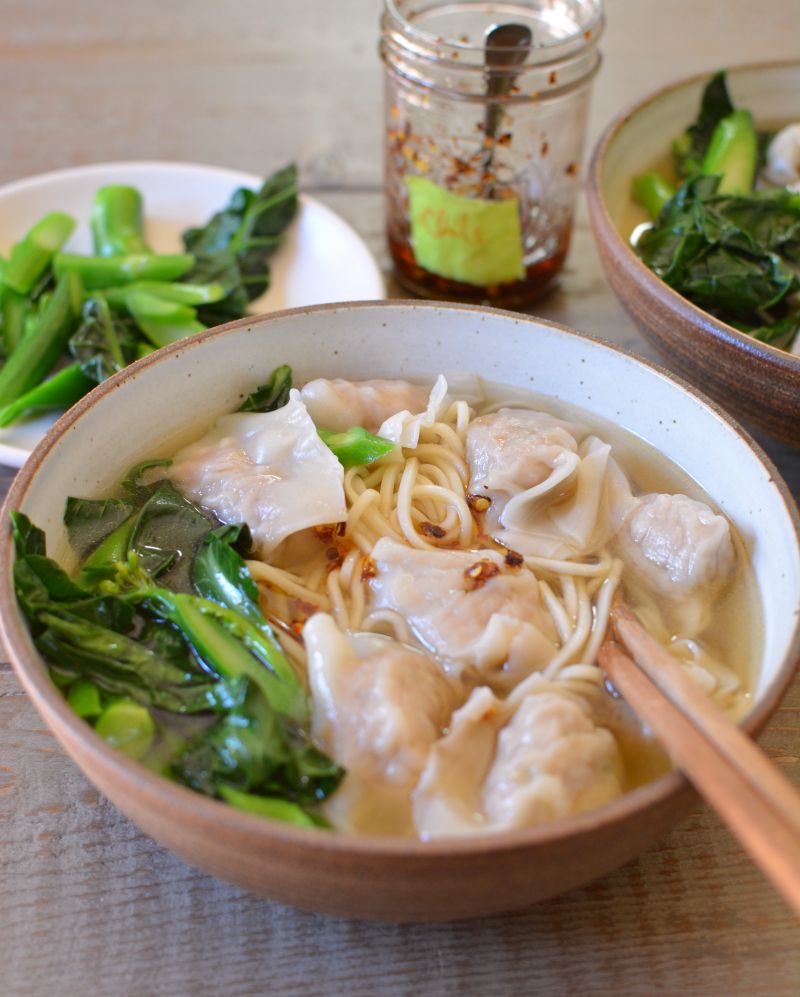
Anthony Bourdain's sudden death triggered an outpouring of emotion from all over, but for me, it eventually led me into the kitchen to make wonton noodle soup and refresh my memory of experiences long ago. My first job after college was with the federal government. I was a bank examiner and quickly learned to hate debits and credits as well as wearing suits and stockings. A good friend from high school told me about the Rotary Foundation International Fellowship program and I realized that it would be my graceful exit from life as a traveling bank auditor. I applied and received a year-long, few strings-attached, expenses-paid fellowship in Hong Kong. I’d already studied Mandarin Chinese in four years and would continue my education at the Chinese University of Hong Kong and pick up a little Cantonese along the way, too. I’d always wanted to study abroad but could never afford to while I was an undergraduate.
It was a dreamy year of being in Hong Kong. The food was outrageously good, especially inexpensive treats like wonton noodle soup, dumplings, egg tarts, and rice plates -- dishes I relished on a student budget. Strangers tended to be curt and rude and the streets were a little dirty. I loved being there from 1991 to 1992.
When I returned fifteen years later to do research for the Asian Dumplings cookbook, Hong Kong was clean, people were kinder, and the food wasn’t as wonderful. Cruise ships lined up on Kowloon side to drop passengers right into an air-conditioned mall. There were department stores that I’d seen in many other parts of the world. The distinctive shops where I’d shopped for folk art and small dumpling places I’d known were gone. The Star Ferry ride between Hong Kong side and Kowloon Side wasn’t as charming.
Wandering Kowloon’s streets in the early evening, I discovered a shop selling kitchen wares and scored a bamboo dumpling filling spreader that I cherish and use to this day. And, I got to watch a man assemble wontons under the glow of a street light. I watched him for several minutes from afar before I got embarrassed and ordered a bowl of wonton noodle soup.
The crinkly Hong Kong-style wontons were made with very thin skins, served in a golden broth that had touches of umami from dried seafood, and paired with chewy thin noodles called bamboo noodles. There was the usual bit of gailan (Chinese broccoli) in the bowl, too. It was delicious and totally iconic. The experience saved me from disliking Hong Kong.
Over the weekend, in preparation for a radio interview about Anthony Bourdain’s influence on Asian cuisines, I watched the recent Parts Unknown episode on Hong Kong and read his field notes. Director Asia Argento captured the essence of Hong Kong in magical ways that reminded me of why the place captivated me so much in the early 1990s.
In one segment, Christopher Doyle, collaborator with Wong Kar-Wai on many Hong Kong movies, including In the Mood for Love, takes Bourdain to eat wonton noodle soup. Theirs is a simple, elemental bowl like the ones I’d savored many times.
Bourdain bemoans the changes in Hong Kong but as usual, the people and little things that he explores cast the beautiful light on Hong Kong’s core appeal. Traveling is about observing and appreciating the human experience. It's not always what you expect.
After I did the interview and was still thinking of Bourdain’s legacy, I decided to make a Hong Kong-style wonton noodle soup. This is the recipe I came up with.
I used the Instant Pot for the broth, which was made with chicken and pork ribs (pork neckbones and leg bones weren’t available and I figured I could use the cooked ribs for another dish). Rock sugar, dried shrimp and shrimp shells helped to build savory-sweet depth.
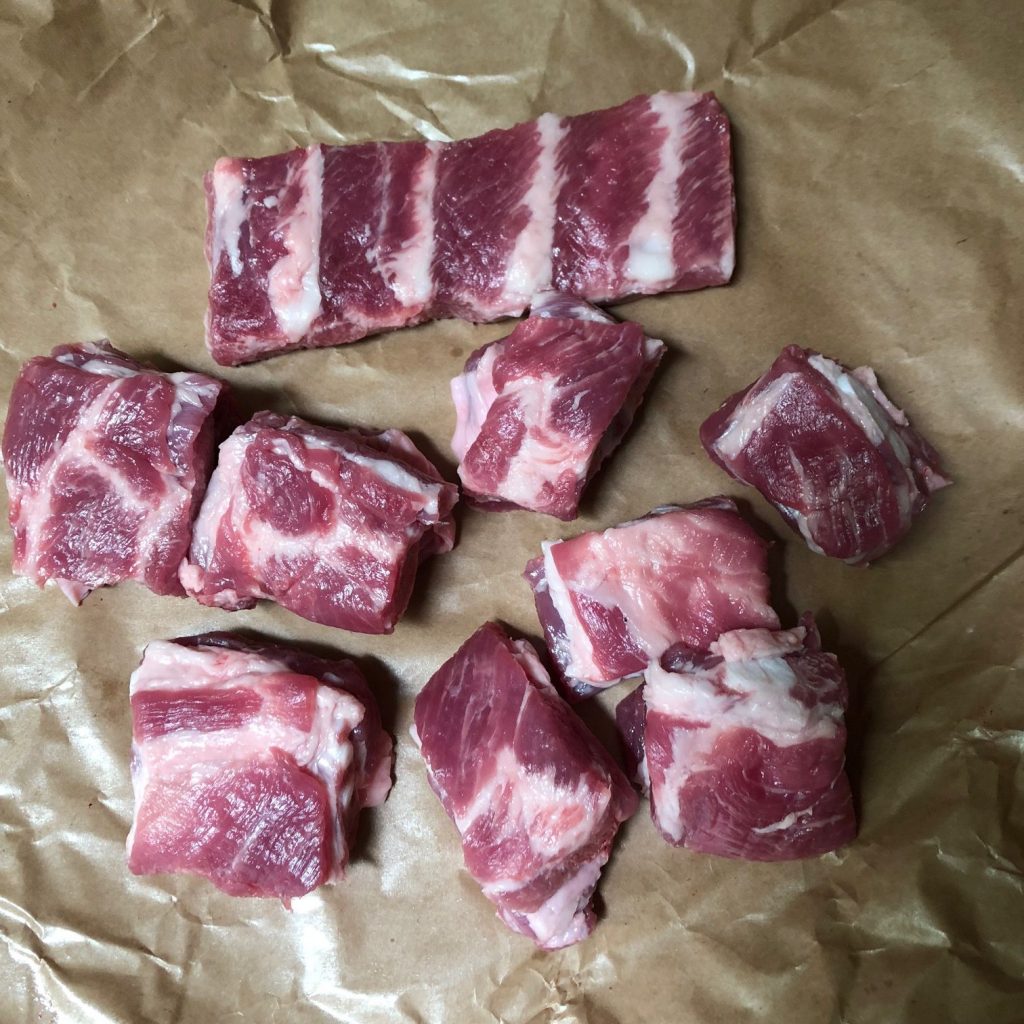
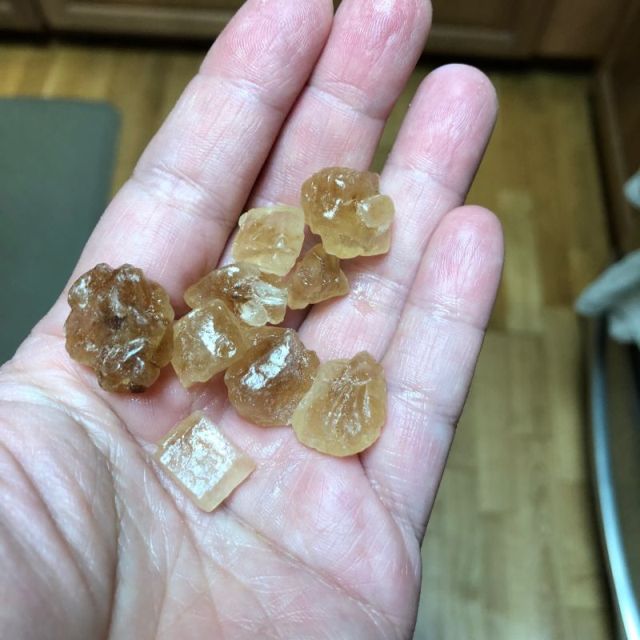
Then I tweaked an Eileen Yin Fei Low recipe in Mastering the Art of Chinese Cooking for the wonton filling, using more shrimp than pork and omitting garlic. Hmong Farmers had awesome gailan so I purchased a bunch. The bamboo noodles are only sold at Asian markets and my substitute was supermarket dried Chinese noodles, which were just fine.
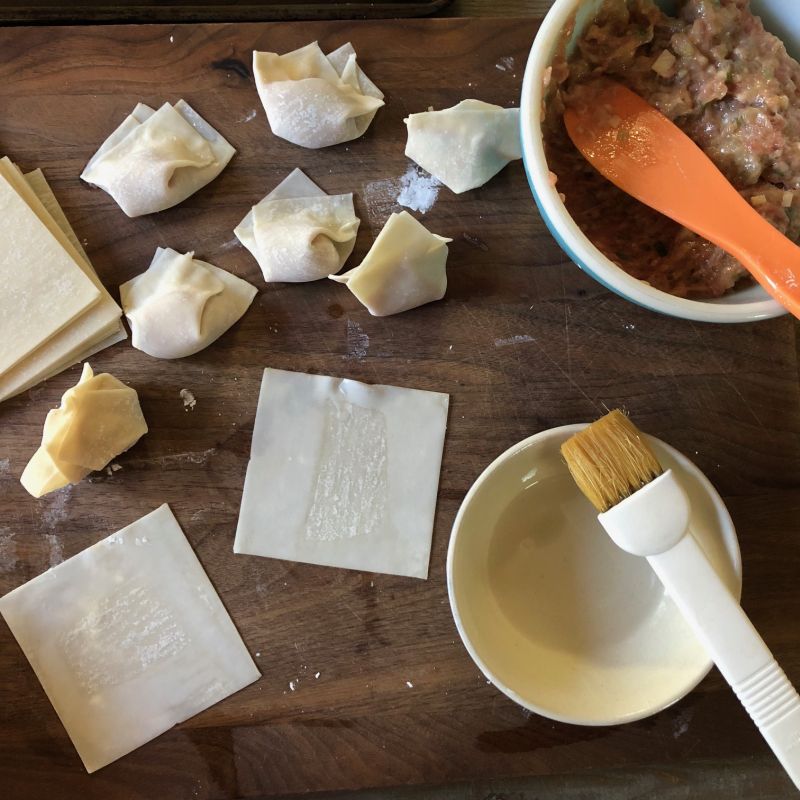
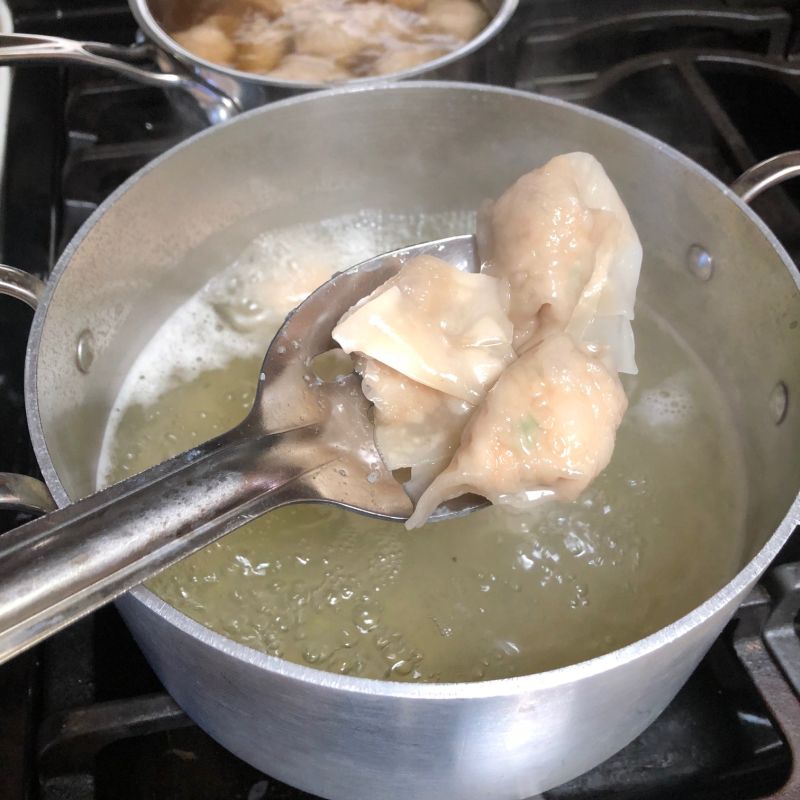
When my husband tasted the resulting bowl of wonton noodle soup, he exclaimed, “This is just DELICIOUS!”
Anthony Bourdain contributed a lot to the world and now that he’s gone, we have to continue exploring and appreciating the details and connections that can be made through food and culture.
Wonton Noodle Soup
Yield 6 servings
To make the broth in a 8 to 10-quart stockpot, parboil the chicken and pork as usual. Then simmer all the broth ingredients along with 12 cups water for 2 hours, uncovered, checking around the 1 ½ hour mark to see if the ribs are tender. Let the broth rest for about 15 minutes before straining and using. In the filling, you can use ground dark meat chicken instead of the ground pork. Or, go all shrimp for the filling!
Ingredients
Broth
- 1 pound chicken backs, necks, or other bony chicken parts
- 2 pounds pork ribs, neck, spine, and/or leg bones, cut into 2-inch pieces
- 1 medium yellow onion, quartered
- Chubby 2-inch piece fresh ginger, unpeeled and smashed with the broad side of a cleaver or chef’s knife
- ½ ounce rock sugar
- Brimming 1 tablespoon dried shrimp
- Shrimp shells (from filling below)
- 1 tablespoon fine sea salt
Wontons
- 6 ounces ground pork, fattier kind is better and if you can get coarsely ground, it’s even better!
- 8 ounces medium shrimp, peeled, deveined and cut into pea-size pieces
- 2 green onions, white and green parts, finely chopped
- 2 tablespoons finely chopped water chestnut, carrot, or jicama
- 1 ½ teaspoons Shaoxing rice wine or dry sherry
- ¾ teaspoon ginger juice (grate it then strain)
- 1 tablespoon oyster sauce
- 1 teaspoon soy sauce
- 1 teaspoon toasted sesame oil
- 2 tablespoons cornstarch plus more for dusting
- ½ to ¾ teaspoon sugar (use the maximum for a stronger sweet-salty finish)
- Rounded ¼ teaspoon fine sea salt
- 2 pinches white pepper
- 1 egg
- 40 to 48 wonton wrappers (one 12-ounce package, such as Nasoya brand)
- 12 ounces gailan, baby bok choy, carrot, green beans, chard or a combination, cut into bite-size pieces
- 12 ounces dried thin Chinese wheat noodles
- 1 tablespoon soy sauce
- White pepper
- Toasted sesame oil or chile oil
Instructions
For the broth
Wielding a heavy cleaver designed for chopping bones, whack the bones to break them partway or all the way through, making the cuts at 1- to 2-inch intervals, depending on the size of the part. This exposes the marrow, which enriches the broth.
Put the chicken and pork ribs in a 6-quart stove top pressure cooker stockpot or electric multicooker like the Instant Pot or Fagor Duo. Add water to just cover. Bring to a boil over high heat to release the scummy impurities (in a multicooker, select a high heat function like Brown on the Duo or adjust the Saute function on the Instant Pot). Turn off the heat. Set a colander in the sink then drain the chicken and pork parts. Spray with water to knock off the impurities. Set aside while you wash the cooker.
Replace the chicken and pork in the cooker, then add the onion, sugar, dried shrimp, shrimp shells, salt and 8 cups water. Lock the lid in place, bring to high pressure, adjust the heat to maintain pressure, then cook for 15 minutes. Slide the cooker to a cold burner and let naturally depressurize for 20 minutes before releasing pressure. (Program a multicooker to cook at high pressure for 15 minutes. Turn off or unplug the cooker, then let naturally depressurize for 25 minutes before releasing residual pressure.)
Skim as much fat from the broth as you like, then strain the broth through a muslin-lined (or paper towel-lined) strainer positioned over a medium (3-quart) pot; you should have about 8 cups. As you work, retrieve the pork ribs and set aside in bowl half-filled with water to cool. When done, discard the other solids. Drain the ribs and set them refrigerate in an airtight container for up to 5 days to use for another dish. Similarly, the broth can be refrigerated for up to 5 days or frozen for up to 3 months.
For the wontons
To make the filling, in a bowl, combine the pork, shrimp, green onion, water chestnut, oyster sauce, soy sauce, rice wine, ginger juice, sesame oil, cornstarch, sugar, salt, pepper, and egg. Stir well with a fork to combine. Cover with plastic wrap and set aside for 30 minutes or refrigerate overnight.
Meanwhile, line a baking sheet with parchment paper and generously dust with cornstarch. Set up a wonton making station with the wrappers, a bowl of water and brush.
Working in batches of 5 or 6 wonton wrappers, brush water on the edges of each wrapper, then fill with about 1 ½ teaspoons of filling. Make your favorite shape.
Place the wontons on the lined baking sheet, with none touching. When done, loosely cover with plastic wrap to prevent drying. Refrigerate overnight or freeze until hard and then transfer to an airtight container to freeze for up to 1 month (partially thaw for 15 minutes before cooking).
Bowl assembly
Bring a large pot of water to a boil. Use a noodle strainer, in batches, blanch the vegetables for about 1 minute, then cool in a bowl of cold water. Boil the noodles in the same pot of water, drain, flush with cold water to cool then set aside to drain. Divide the noodles and vegetables among six noodle soup bowls.
Reuse the same big pot to cook the wontons. Fill it halfway with water and bring to a boil. Meanwhile, in s medium pot, combine the broth and 1 tablespoon soy sauce then reheat over medium-high heat; lower the heat and cover if it comes to a boil.
Add the wontons to the large pot of boiling water, dropping each in and nudging it to prevent sticking. Once they float to the top, let cook for 1 minute until translucent and plump, then use a slotted spoon or spider to transfer to the hot broth.
Let the wonton finish cooking in the hot broth for 2 to 3 minutes, then divide among the bowls. Finish with a pinch of white pepper. Drizzle on sesame oil or chile oil. Serve immediately.













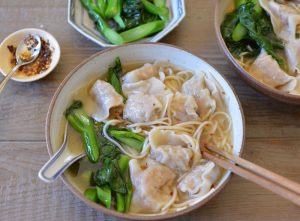




Alonna Smith says
Hi Andrea,
Thanks so much for this post. I am having trouble getting my equilibrium since the news of Anthony's death. This a perfect tribute to him.
Andrea Nguyen says
My pleasure, Alonna!
Phil Shima says
Hi Andrea - I believe the tradition of blanching the meats and discarding the water to rid the broth of the cooked albumin bits is from traditional recipes such as making consommé. But since many recipes call for straining the finished broth through muslin, I don't see the point, esp. when used for down-home food like wonton soup. Do you do this at home, and what would Tony Bourdain think about the stray bits of albumin floating in his tasty wonton soup?
Andrea Nguyen says
I've done side-by-side tests and the parboil ensures a clean flavor and appearance. Straining through musline is great because it's the better cheesecloth. Many people strain through a strainer. I don't think of wontons in broth as a down-home dish. It's simply elegant. None of the renditions I've had have had strange bits of denatured proteins in the broth. Have you encountered that much?
Phil Shima says
I'm not much concerned about the appearance, but a cleaner flavor would be worth the extra step. I'll give it a try next time.
Andrea Nguyen says
Give it a whirl!
Laura M says
Thank you for such a thoughful tribute. I can't wait to try the "messy" wonton noodle soup.
Andrea Nguyen says
My pleasure. Happy wonton-ing.
Michael says
I will be making this soon. I'm still on the hunt for a bamboo dumpling spatula. I go to every asian market in every city I visit, my family thinks it's funny because of how obsessed I am about finding one and how I never seem to hahah
Andrea Nguyen says
It's really hard to find good ones. I bring silicone or plastic spreaders to class. Just now, I saw these bamboo ones that you may want to look for:
https://amzn.to/2JAY5S1
Karen Lantz says
If one doesn’t have a pressure cooker, how would you suggest adjusting the cooking time of the broth?
In honor of Anthony Bourdain, I am being inspired to reach new heights by trying this recipe, one that in the past, I would have thought sounded delicious, but ended it there.
Thank you!
Karen
Andrea Nguyen says
Hi Karen, There's a little note at the beginning of the recipe for how to make the broth in a stockpot. Continue to be inspired and try new things!
Mark Banana says
Wonton soup looks so good and thinking about Anthony makes me thinking about bánh xèo and if you would share how to make that great dish. I am currently living in provincial town Chanthaburi Thailand where there is many colonial French, Vietnamese and Khmer cooking influences. The other day I stopped at this small Vietnamese joint and had stunning crispy pancake stuffed with vegetables, mushrooms and pork ( I am mostly vegetarian) that I had to eat it and it was so good. I see recipes on you tube but none of them can match the texture and crispines of the pancake I had here. I guess the secret is to make the pancake using hot wok at perfect temperature. Maybe you can research and post recipe on your website.
Kind Regards
Mark Banana
Andrea Nguyen says
Hello Mark, So happy you enjoy the rice crepes!!! I have Thai friends who like it. I have a terrific banh xeo recipe in my book, "Into the Vietnamese Kitchen". In America, many libraries have the book and bookstores do too. You can purchase the ebook for portability and frankly, less money, since you're oversees. Here it is on Amazon but it's available wherever books are sold: https://amzn.to/2NyMKzs
Thank you!!
Tiffany Cheng says
I love Wonton Noodles, I have eaten Wonton Noodles at Macau when I was waitibg for a ferry to cross to Hong Kong.
Yun Ho Rhee says
Hi Andrea.
I think your Hu Tieu Nam Vang broth recipe is just as good as making the broth for Wonton Soup. It is closer to the taste of Wonton noodle soup I had when I was growing up in Saigon !!
Andrea says
I do love that broth recipe, Yun Hoo. Just made a batch the other day.
Heidi says
I can’t eat pork or shrimp. Do you have any suggestions for substitutes? (I realize the flavor will be different,)
Andrea Nguyen says
Ground chicken thigh is a great substitute. If you like, add a little cornstarch because it's softer and more moist than pork and shrimp, so the chicken may be a bit hard to manipulate as a filling.
Alisha Nguyen says
Very classy, just like Bourdain. It's worth it to make your own wonton skins here. I wasn't able to find Nasoya brand wrappers at my local grocer and the ones I did find had some unwelcome ingredients, including preservatives. I decided to try making wonton skins with bread flour and the result was a lovely, pliable, easy to roll out dough. My husband and I enjoyed the soup with a glass of white wine. It felt like we were dining in a fine restaurant!
Andrea Nguyen says
Very nice! Homemade wonton skins are amazing for fried ones. Ethereal, actually. I use my recipe in "Asian Dumplings".
Melody Lema says
This totally made my family love me! Thank you so much.
Today, I woke up to a sick, grumpy husband, who has the creeping crud. I get a phone call from my daughter-in-law telling me that my son (age 48) is sick, and then a text from my granddaughter telling me that her new husband, my grandson is sick, what does she do? I told them to come to my house, got out my brand new 8 at instant pot, and looked on your website. This sounded perfect for the sore throats, the aching bodies, and stuffy noses.
As it was cooking, the scent of the broth was making my grouchy crew hungry, as they were drinking broth and eating crackers. (Everything was homemade, including the saltines). After the wives, other siblings got home, the table was set, my great grandmother's soup tureen was warmed, and then filled. (The soup tureen came from the Azores Islands to America when my Great-Grandparents immigrated with their 6 kids, eventually 10, in 1896. The tureen was something that was an indicator of a good cook. My Great-Great-Grandmother had it made for her daughter, my great-Grandmother. My Great-grandmother skipped 2 generations and gave me the tureen. I would cook and cook with her, soups are my favorite) The 8 of us are everything. And the blessing on the food including thanks for Andrea Nguyen.
Andrea Nguyen says
Wow. Thank you for cooking and taking time to write such kind feedback. Wow. Wow. Wow. You made my day, Melody!
Linh says
Hi Andrea,
thank you so much for such a comprehensive recipe. I made the broth tonight, do I have to strain it before going to bed or can I leave everything as it is and take care of it tomorrow? Thanks!
Andrea Nguyen says
I imagine that you've strained it by now. In the main, you can leave it till the next day but cover and refrigerate it. Hope you enjoyed the broth!